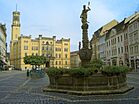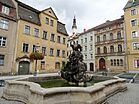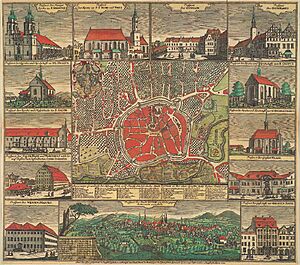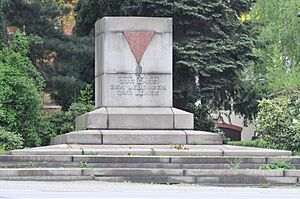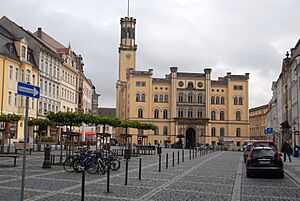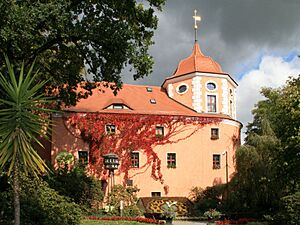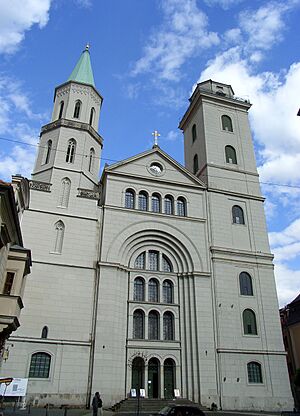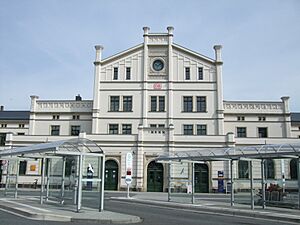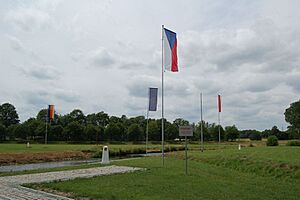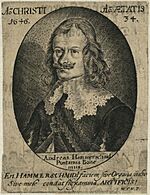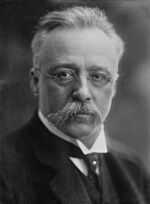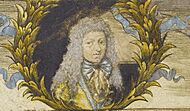Zittau facts for kids
Quick facts for kids
Zittau
Sitte
|
||
|---|---|---|
|
Clockwise from top:
Market Square with town hall Neustadt Square with Swan Fountain view of Zittau from Oybin Mountain skyline of Zittau with the towers of the Johanneum, Monastery Church, St John's Church and the town hall Samaritan's Fountain on Neustadt Square Roland Fountain on Market Square |
||
|
||
| Country | Germany | |
| State | Saxony | |
| District | Görlitz | |
| Elevation | 242 m (794 ft) | |
| Population
(2022-12-31)
|
||
| • Total | 24,794 | |
| Time zone | CET/CEST (UTC+1/+2) | |
| Postal codes |
02763
|
|
| Dialling codes | 03583 | |
| Vehicle registration | GR, ZI | |
| Website | www.zittau.de | |
Zittau (pronounced ZIT-ow) is a city in the southeastern part of Germany. It is located in the state of Saxony, close to the borders with Poland and the Czech Republic. About 25,000 people live in Zittau, making it an important city in the Lusatia region.
Zittau's city center is very old and beautiful. You can see many buildings from different time periods. Some famous ones include the town hall, which looks like an Italian palace, and the Church of St. John. The old stables, called the Salzhaus, are one of the oldest buildings of their kind in Germany. Zittau is also the birthplace of the famous German composer Heinrich Marschner.
Contents
Where is Zittau Located?
Zittau is built along the Mandau River. The Lusatian Neisse River, which forms the border with Poland, flows along the city's eastern side. These two rivers meet in the southeast of Zittau.
Just south of the city, there is a special spot called a "tripoint." This is where the borders of Germany, Poland, and the Czech Republic all meet. The village of Hartau, which is part of Zittau, is also located where the Lusatian Neisse forms a short part of the German-Czech border.
Zittau is in a flat area called the Zittau Basin. To the north, you can see the Zittau Mountains, which are part of the larger Sudetes mountain range. Very close to Zittau, on the Polish side of the border, is the Turów Coal Mine. This is one of the biggest human-made holes on Earth and can even be seen from space!
What is Zittau's Climate Like?
Zittau has a cool, mild climate. This means it has cool winters and warm summers. The average temperature for the whole year is about 8.6 °C (47.5 °F). The city gets about 883 mm (34.8 inches) of rain each year, and it rains fairly evenly throughout all twelve months.
A Look at Zittau's History
The story of Zittau began with a Slavic settlement in the 1100s. For a long time, the area was part of the Kingdom of Bohemia (which is now the Czech Republic). The city was first officially mentioned in 1238, using the Latin name Sitavia.
In 1255, King Ottokar II of Bohemia gave Zittau its official "town rights," allowing it to govern itself. He also built strong walls to protect the city. Zittau's coat of arms still shows a Czech Lion and a Silesian Piast Eagle, showing its historical ties.
In 1346, Zittau became one of the important members of the Six-City League of Upper Lusatia. During this time, Zittau was known as "Die Reiche" (meaning "the Rich"). This was because many wealthy citizens lived there. The city faced big fires in 1359 and 1422, which caused a lot of damage.
Zittau remained part of the Bohemian Crown until 1635. Then, it became part of the Electorate of Saxony. After the Battle of White Mountain in 1620, many Protestant people from Bohemia came to Zittau. The Protestant rulers of Saxony welcomed them.
In the 1500s, beer was a very important product that Zittau traded. Later, in the 1700s and 1800s, making textiles (cloth and fabric) became a big industry in the region.
During World War II, a Nazi prison and a labor camp were located in Zittau. People were forced to work there for a truck-making company.
What to See in Zittau
Zittau has many interesting places to visit:
- Church of Our Lady: This church has a semi-Gothic style and was first mentioned in 1355.
- City Hall: Designed by Karl Friedrich Schinkel, this building was built between 1840 and 1845. It looks like an Italian palace.
- Flower Clock: A very popular attraction, this clock was built in 1907 using parts from an old tower clock. It has about 4,800 plants that are changed three times a year!
- Friary Church: This was once the church of the Franciscan Monastery. Its main part was built in 1480 in a late Gothic style.
- St. John's Church: Originally built in 1230, this church was destroyed in 1757 during a war. The current building was rebuilt between 1766 and 1837.
- Zittau Lenten Altar Cloths: These are two very large, decorated cloths. They were used to cover the altar during the Christian season of Lent. The larger one (56 square meters) is from 1472 and is shown in the Gothic Holy Cross Church. The smaller one (15 square meters) is from 1573 and is in the Museum of Cultural History.
- Historic Fountains: Zittau has many old and beautiful fountains, including the Green Fountain (1679), Roland Fountain (1585), and Swan Fountain (1710).
- Neustadt Square: This square features the Salt House, a large building from 1511 that was used as a warehouse and stables.
- Old Grammar School and Dornspach's House: These are examples of Renaissance-style buildings.
Learning and Education in Zittau
Zittau is a place for learning! Around 3,500 students attend the Zittau/Görlitz University of Applied Sciences. There is also a small, independent International Graduate School. These schools welcome students from nearby Poland and the Czech Republic.
How to Get Around Zittau
Road Travel
Zittau is connected to the Czech Republic by a good dual-carriageway road. While it doesn't have a direct connection to major highways within Germany yet, one is planned for the future.
Train Travel
Zittau railway station is just north of the city center. You can travel by train to Dresden and even directly to Liberec in the Czech Republic. Trains also connect Zittau to Görlitz (with connections to Poland) and Cottbus (with connections to Berlin). The railway line from Zittau to Löbau, opened in 1848, is one of the oldest in Germany.
Zittau also has a special narrow-gauge railway! This historic train takes passengers from Zittau to the mountain spa towns of Oybin and Jonsdorf in the Zittau Mountains. It's a fun way to see the area.
Crossing Borders in Zittau
Zittau is very close to where Germany, the Czech Republic, and Poland meet. There are several places where you can cross the border. Since December 21, 2007, when all three countries became part of the Schengen Area, you can cross these borders without stopping for passport checks.
Germany to Czech Republic Crossings
- Hartau – Hrádek nad Nisou: This crossing is in the village of Hartau, south of Zittau, and is only for people walking.
Germany to Poland Crossings
- Zittau Chopinstraße – Sieniawka: This is a road bridge over the Lausitzer Neisse River, which forms the border. The Polish town on the other side is Sieniawka.
- Zittau Friedenstraße – Porajów: Another road bridge over the Lausitzer Neisse River, south of Zittau. This crossing is often used by people going to the Czech Republic.
- Zittau Lusatiaweg – Porajów: This bridge was closed for a while but reopened in December 2007 for walkers and cyclists.
Zittau is unique because it's the only city along the Oder–Neisse line where some river bridges are still not open for international crossings, even though both Germany and Poland are in the Schengen Area.
Zittau's Sister Cities
Zittau has "sister city" relationships with several other cities around the world. This means they share cultural and educational exchanges.
 Bogatynia, Poland
Bogatynia, Poland Hrádek nad Nisou, Czech Republic
Hrádek nad Nisou, Czech Republic Liberec, Czech Republic
Liberec, Czech Republic Pistoia, Italy
Pistoia, Italy Portsmouth, United States
Portsmouth, United States Villingen-Schwenningen, Germany
Villingen-Schwenningen, Germany Zielona Góra, Poland
Zielona Góra, Poland
Famous People from Zittau
Many interesting people were born or lived in Zittau, including:
- Ernst Baier (1905–2001), a figure skater who won an Olympic championship.
- Max Fiedler (1859–1939), a conductor and composer.
- Andreas Hammerschmidt (c. 1611–1675), a composer and organ player.
- Johann Kuhnau (1660–1722), another composer, organist, and harpsichord player.
- Heinrich Marschner (1795–1861), a famous composer.
- Lisa Tetzner (1894–1963), a well-known children's author.
- René Sommerfeldt (born 1974), a cross-country skier.
|
See also
 In Spanish: Zittau para niños
In Spanish: Zittau para niños



